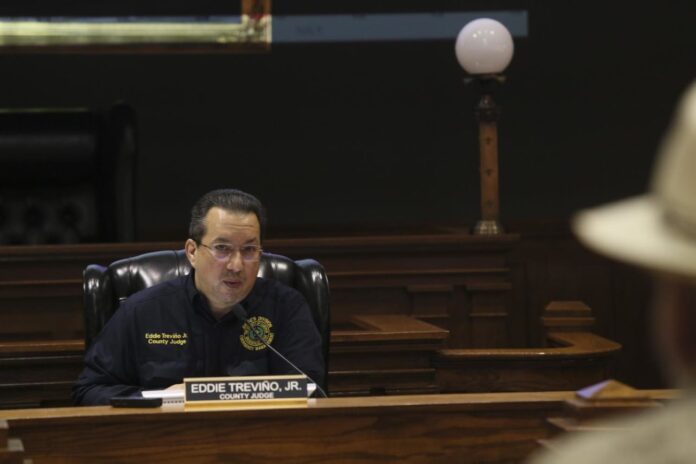At a Monday press conference, Cameron County Judge Eddie Treviño Jr. said a “step-down” care facility for recovering COVID-19 patients could be operational by the end of the week at Casa de Amistad in Harlingen.
The temporary facility to be housed in the 13,000-square-foot convention hall is being provided by the state for COVID-19 hospital patients who no longer need acute care but still aren’t well enough to go home, he said. County Health Authority Dr. James Castillo said the step-down facility will help the county’s four community hospitals make the best possible use of their space.
Hospitals, doctors, nurses and medical staff have been pushed nearly to the limit by the surge, but have avoided being overwhelmed thanks to outside help from the Navy and the state of Texas, he said.
“Honestly if we didn’t have that help, the hospitals could not manage the number of patients they have with coronavirus right now and still take care of all the other illnesses that are still coming their way,” Castillo said. “It’s absolutely still a disaster, but it seems to be leveling.”
He noted that many people who contract the virus “are taking a long time to get better.” Almost a quarter of COVID-19 survivors report still having symptoms even after three weeks, and some still require oxygen long after the disease has left their bodies, Castillo said.
The county as of July 25 had confirmed 7,827 positive COVID-19 cases, Treviño said he expected that figure to be surpassed Monday. The county was reporting 177 virus-related deaths as of Saturday, but says the number will increase as the health department works through the backlog created by the massive surge in cases over the past few weeks.
“We continue to expect that to be the case for the next anywhere from two to six weeks as we continue to catch up,” Treviño said.
Even with the lag in reporting, it’s distressing that confirmed deaths related to the virus jumped from 96 a week ago to 177 as of Saturday, he said. The number of confirmed cases has grown by 2,587 over the last eight days, exceeding the cumulative total for the four months leading up to July 1, Treviño said. A total of 61,330 county residents have been tested, with 53,503 “presumed negative,” 3,223 cleared/recovered and 4,427 pending results, he said.
The percentage of people testing positive is nearly 13 percent — not as bad as some areas but still not good, Treviño said. At any rate, it’s up from 10.1 percent two weeks ago, an indication of growing spread. In Texas as of Monday there were 381,656 total cases and 5,038 deaths related to the virus. The United States had 4.2 million cases and 146,000 deaths as of Monday, Treviño reported.
The county is averaging more than 320 new confirmed cases with each reporting cycle, a trend that could continue for weeks, he said. Treviño said he’s received a number of calls from people wondering why the county hadn’t reimposed a shelter-in-place mandate.
“The truth of the matter is we ordered it a month ago,” he said. “But it’s the same dilemma that the rest of the state has, because the governor has not given back our authority in regards to shelter-in place so we can only make recommendations.”
Castillo said the county is seeing a consistent pattern of families and friends spreading the virus amongst themselves, noting that all it takes is for one person to be infected, and that person may be asymptomatic and not even know they’re infected.
“That’s when we’re most likely to get our guard down,” he said. “We definitely saw a spike after the Fourth of July weekend,” he said. “We see that spike after holidays, and I believe it’s a lot of our family gatherings. Keep that in mind.”
It’s important to wear facial coverings, but it’s not a substitute for social distancing, Castillo said. It’s also important to wash your hands, and stay home if you feel sick, he said. Castillo said that people who think they’ve been exposed to the virus need to self-quarantine for 14 days. The definition of exposure is spending more than 15 minutes within six feet of someone who has recently tested positive, he said.
“You need to stay home and quarantine and not cause other exposures,” Castillo said. “If you decide to get tested, the best time to get tested is about 6 to 8 days after the exposure. Even if it tests negative you still need to quarantine.”





